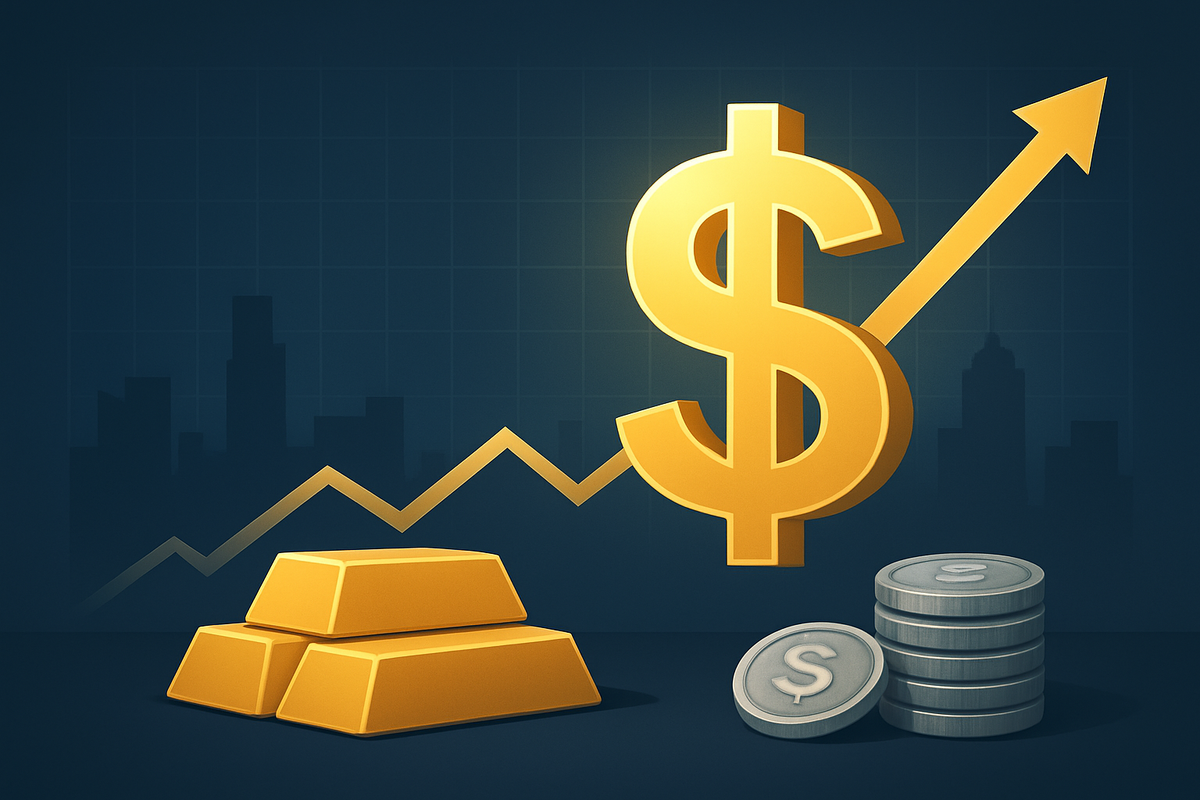
November 19, 2025 - The US Dollar Index (USDX) has exhibited a renewed and formidable rally in November 2025, sending ripples through global financial markets and placing significant downward pressure on the prices of precious metals, specifically gold and silver. Driven by a confluence of hawkish signals from the Federal Reserve, robust domestic economic data, and persistent safe-haven demand, the strengthening dollar is making dollar-denominated commodities more expensive for international investors, eroding their recent gains and prompting a wave of profit-taking. This dynamic signals a recalibration of market expectations, as the appeal of zero-yield assets like gold and silver wanes in the face of a more assertive US monetary policy outlook.
Hawkish Fed and Robust Economy Bolster Greenback, Dampening Precious Metal Appeal
The current surge in the US Dollar Index (USDX), which closed at 99.632 on November 19, 2025, is primarily a consequence of the Federal Reserve's less dovish rhetoric, which suggests a lack of urgency for imminent rate cuts. Market probabilities for a December rate cut have significantly diminished, with some analysts noting a "less dovish" Fed as a direct contributor to the dollar's strength. Expectations for the Fed's terminal rate in 2025 have even climbed to 3.76%, surpassing the central bank's own projections from just two months prior. This hawkish stance is underpinned by resilient US economic data, including robust services sector performance, steady retail sales figures, and an uptick in core inflation, all of which challenge earlier assumptions of an impending economic slowdown.
Further contributing to the dollar's ascent is the anticipation of crucial economic data releases, particularly the minutes from the Fed's October 28-29 meeting and the delayed US September jobs report. These reports are expected to clarify the Federal Reserve's future rate trajectory, providing pivotal triggers for market direction after a period of "data fog" caused by a recent US government shutdown. Geopolitical tensions and lingering political uncertainty also continue to reinforce the dollar's traditional safe-haven appeal, drawing capital back to the United States. Simultaneously, disappointing eurozone purchasing managers index (PMI) data has fueled speculation of potential 50 basis point rate cuts in Europe as early as January 2025, further widening interest rate differentials and bolstering demand for the US dollar.
The immediate impact on gold and silver has been a pronounced retreat from their recent highs. Gold, which had reached an all-time high of $4,381.58 in October 2025, experienced a significant daily decline of nearly $200 on November 14th and continued its slide, trading at $4031 on November 18th, marking its fourth consecutive decline. As of November 19, 2025, spot gold rose slightly to $4,072.37 per ounce, but overall, it has fallen by 6.52% over the past month. Silver, despite achieving a new all-time high of $54.42 per troy ounce on November 14th, also saw profit-taking, settling at $50.40 on the same day. As of November 19, 2025, silver rose to $51.30 USD/t.oz, but has still fallen by 1.97% over the past month. The rising 10-year US Treasury real yields, which broke above 1.77%, further increase the opportunity cost of holding non-yielding assets like gold and silver, adding to their downward pressure.
Mining Giants Face Headwinds as Dollar Strength Squeezes Margins
The robust US dollar presents a mixed, but generally challenging, landscape for public companies deeply entrenched in the precious metals sector, particularly mining operations. For major gold miners like Barrick Gold (NYSE: GOLD) and Newmont (NYSE: NEM), a stronger dollar translates into lower realized prices for their primary product when converted from USD to their operational currencies, particularly if a significant portion of their costs are in local, weaker currencies. While some operational costs might be denominated in USD, many global mining operations incur expenses in the currencies of the countries where their mines are located. A declining gold price in USD terms directly impacts their top-line revenue and, consequently, their profitability.
Similarly, silver mining companies such as Pan American Silver (NASDAQ: PAAS) and Wheaton Precious Metals (NYSE: WPM) will also feel the pinch. Although silver has demonstrated remarkable resilience and even surpassed gold in percentage gains over the past year, the current dollar strength and subsequent price correction will affect their revenue streams. For royalty and streaming companies like Wheaton Precious Metals, which acquire precious metal streams at a fixed cost, a drop in market prices reduces the value of their acquired metal, potentially narrowing their margins. Furthermore, companies with significant debt denominated in USD but revenues in other currencies could see their debt servicing costs effectively increase, adding another layer of financial pressure. Conversely, companies with a large proportion of their costs in USD and revenue in other currencies might see some benefit, but this is less common for major precious metals producers whose primary product is priced globally in USD.
The broader implications extend to exploration and development budgets. With lower commodity prices, the economic viability of new projects can be questioned, potentially leading to deferrals or cancellations of capital expenditures. This could impact not only the mining companies themselves but also their suppliers of equipment, services, and labor. Investors in these companies may also re-evaluate their positions, leading to potential stock price volatility as market sentiment shifts away from precious metals as a primary investment vehicle during periods of dollar strength and rising real yields. The ability of these companies to manage their currency exposures and operational efficiencies will be critical in navigating this challenging environment.
Broader Implications: A Shift in Global Investment Flows and Historical Echoes
The current US dollar rally and its impact on precious metals transcend mere price movements; they signify a broader shift in global investment flows and risk perception. The dollar's strength often reflects a preference for US assets, driven by higher interest rate differentials, economic stability, and its safe-haven status during times of global uncertainty. This phenomenon is not isolated, fitting into broader industry trends where investors reallocate capital from non-yielding assets to interest-bearing instruments or stronger currencies. The increased opportunity cost of holding gold and silver, exacerbated by rising US Treasury yields, makes alternative investments more attractive, particularly in a landscape where the Federal Reserve is perceived as maintaining a tighter monetary policy for longer.
Ripple effects are evident across the commodity complex and other currency markets. A strong dollar typically weighs on other dollar-denominated commodities, potentially impacting oil, copper, and agricultural products, though the specific drivers can vary. For competing currencies, such as the Euro and the Yen, the dollar's appreciation can lead to depreciation, affecting international trade balances and economic policies in those regions. Regulatory and policy implications are also significant; central banks globally will closely watch the Federal Reserve's actions, potentially influencing their own monetary policy decisions to manage currency strength and inflation. Historically, periods of sustained dollar strength have often coincided with weakness in precious metals. For instance, in the early 2000s, a strong dollar phase put pressure on gold, only for it to rally significantly once the dollar began to weaken. Similarly, the mid-1990s saw gold under pressure during a period of robust US economic growth and dollar strength. These historical precedents suggest that while the current environment is challenging for precious metals, market dynamics can shift rapidly, often in response to changes in central bank policy or global economic outlooks.
The current situation also highlights the ongoing debate about the role of gold as an inflation hedge versus a safe-haven asset. While gold has seen significant appreciation over the past year (up 53.60%), suggesting its role as a hedge against longer-term inflation concerns, the immediate reaction to a hawkish Fed and rising real yields demonstrates its sensitivity to monetary policy. This interplay underscores the complex factors that influence precious metals pricing, often making them a barometer for broader economic and geopolitical sentiment.
What Comes Next: Navigating Volatility and Shifting Market Dynamics
Looking ahead, the trajectory of the US dollar and its subsequent impact on gold and silver will largely hinge on the Federal Reserve's monetary policy decisions and the evolving landscape of global economic data. In the short-term, the market will be keenly awaiting further clarity from the Fed's upcoming meeting minutes and key economic reports, particularly the US jobs report. Any signals that suggest a continued hawkish stance or further delays in rate cuts could further bolster the dollar, prolonging the downward pressure on precious metals. Conversely, unexpected signs of economic weakening or a shift towards a more dovish Fed outlook could quickly reverse the dollar's fortunes, providing a much-needed tailwind for gold and silver.
In the long-term, several potential scenarios could unfold. If global geopolitical tensions persist or escalate, the dollar's safe-haven appeal might continue to support its strength, albeit with intermittent corrections. However, if inflation proves more persistent than anticipated, or if global central banks embark on a more aggressive rate-cutting cycle, gold and silver could regain their luster as inflation hedges and alternative stores of value. Strategic pivots for investors might involve diversifying portfolios to account for currency fluctuations and re-evaluating the role of precious metals within a broader asset allocation strategy. Market opportunities may emerge for those who can accurately anticipate shifts in monetary policy or identify undervalued mining companies that demonstrate strong operational resilience and cost control. Challenges will undoubtedly include managing increased market volatility and navigating an environment where traditional correlations between assets may temporarily break down. Potential outcomes range from a sustained period of dollar dominance and precious metal consolidation to a swift reversal driven by unforeseen economic or geopolitical events, making adaptability a key trait for market participants.
Wrap-Up: A Crossroads for Precious Metals in a Dollar-Driven Market
The current strength of the US dollar, propelled by a hawkish Federal Reserve and robust economic indicators, presents a significant crossroads for the precious metals market. While gold and silver have experienced impressive rallies over the past year, the immediate impact of the USDX surge has been a notable retreat from recent highs, driven by profit-taking and the increased opportunity cost of holding non-yielding assets. This period underscores the powerful inverse relationship between a strong dollar and dollar-denominated commodities, reminding investors of the intricate dance between currency strength, monetary policy, and commodity valuations.
Moving forward, investors should closely monitor the Federal Reserve's rhetoric and any incoming economic data that could signal a shift in its policy trajectory. Key takeaways include the dollar's enduring safe-haven appeal, the sensitivity of precious metals to real interest rates, and the potential for significant volatility as market participants recalibrate their expectations. While the short-term outlook for gold and silver appears challenged by dollar dominance, their long-term roles as hedges against inflation and geopolitical uncertainty remain relevant. The market will be watching for any signs of global economic slowdowns, a more dovish pivot from central banks, or escalating geopolitical risks, all of which could reignite demand for precious metals. Ultimately, the ability to adapt to evolving market dynamics and understand the fundamental drivers of currency and commodity prices will be crucial for navigating the months ahead.
This content is intended for informational purposes only and is not financial advice





